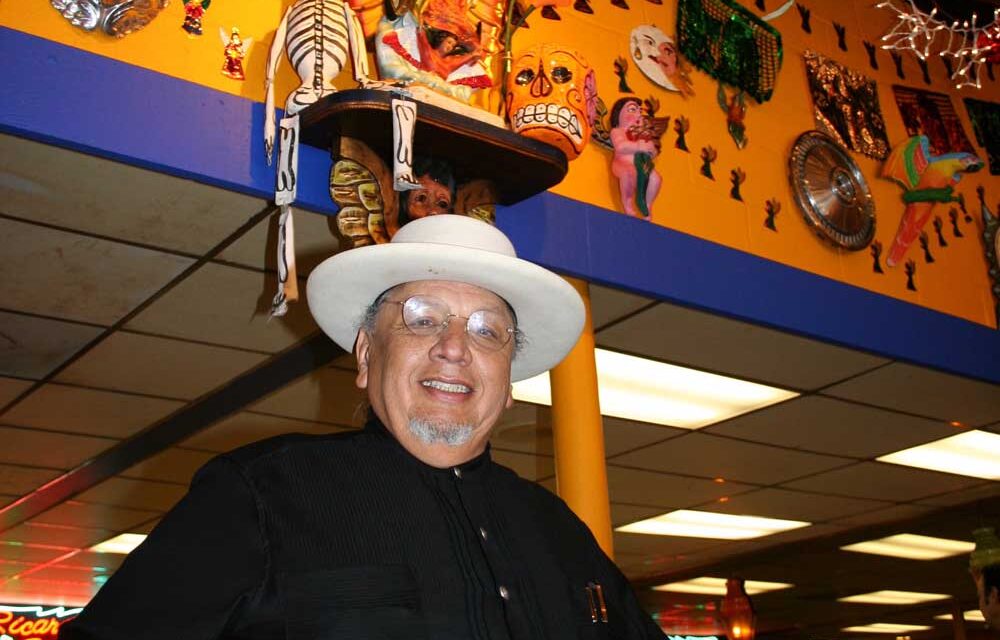Cover Photo Courtesy of Dr. Ricardo Romo
Jorge Cortez, the creative force behind San Antonio’s iconic Mi Tierra restaurant and a tireless champion of Latino culture, died at the age of 81, surrounded by his loving family. His passing marks the end of an era for a man who transformed a modest family restaurant into a cultural cornerstone of San Antonio’s West Side.
Known for his signature white hat, guayabera, and red apron, Cortez was more than a restaurateur – he was an artist, visionary, and cultural preservationist whose influence extended far beyond the walls of Mi Tierra. His son Pete Cortez perhaps said it best: “He was small in size, but he was a giant. He was almost like a little pebble in a big lake, and the ripples are like tidal waves.”
Born into a family of restaurateurs, Jorge Cortez, along with his siblings David, Ruben, Manuel, and Rosalinda, took the helm of La Familia Cortez’s restaurant empire in 1984 following the death of their father and founder, Pedro Cortez. Under their stewardship, what began as a three-table café in 1941 grew into a collection of beloved establishments including Mi Tierra, Pico de Gallo, Mariachi Bar, Mi Familia at The Rim, and La Margarita.
But Jorge Cortez’s vision extended beyond serving meal. He saw his restaurants as cultural institutions where generations of Mexican Americans could celebrate every facet of life – from baptisms and weddings to quinceañeras and funerals. The vibrant murals adorning Mi Tierra’s walls, which he personally curated, serve as a living chronicle of Mexican American history in San Antonio’s West Side.
Cortez’s impact on San Antonio’s cultural landscape was profound and far-reaching. He played a pivotal role in establishing La Zona Cultural, the historic district across downtown San Antonio’s west end. He was instrumental in founding the Centro de Artes Gallery, which showcases Latino artists, and was a driving force behind the restoration of the historic Alameda Theater.
His creativity knew no bounds. An artist himself, taught by his close friend, the late Jesse Treviño, Cortez was known for his unique way of visualizing ideas – framing scenes with his fingers and sketching his visions on napkins. His culinary innovations, including the introduction of sizzling fajitas, helped shape modern Tex-Mex cuisine.
Jorge Cortez was deeply committed to his community and employees. Raul Salazar, the company’s longest-serving employee of 54 years, shared how Cortez helped him and others build better lives, assisting with everything from documentation to home ownership. “Back then, it wasn’t La Familia Cortez. It was Jorge. Jorge levanto todo esto (Jorge built all of this),” Salazar recalled.
A graduate of Central Catholic High School and St. Mary’s University, where he earned a business and marketing degree, Cortez also served his country as a U.S. Air Force veteran from 1961 to 1965.
Jorge Cortez is survived by seven children: Pete, Deborah, Christina, Paloma, Cariño, Alexandra, and Sol Jorge; twelve grandchildren; and a great-grandchild. His family remembers him as a dynamic personality who brought joy and creativity to everything he touched, from his distinctive cologne to his dancing through the kitchen to the mariachi music.
The community had the opportunity to honor Jorge Cortez at a celebration of life ceremony at Porter Loring Mortuary. A funeral procession passed through La Zona Cultural, with employees lining the streets to bid farewell to their beloved leader. Archbishop Gustavo Garcia-Siller co-officiated the mass at San Fernando Cathedral.
True to his artistic spirit and cultural dedication, Cortez was buried wearing his iconic white guayabera, slacks, apron, hat, and his cherished chain bearing a palomita (white dove). In lieu of flowers, the family requested donations to the Alameda Theater Conservancy, ensuring that his vision for cultural preservation continues.
As San Antonio mourns the loss of this cultural giant, his legacy lives on in the vibrant cultural district he helped create, the restaurant empire he built, and the countless lives he touched with his generosity and vision. Jorge Cortez’s story embodies the American dream while never forgetting the cultural roots that made that dream possible.











